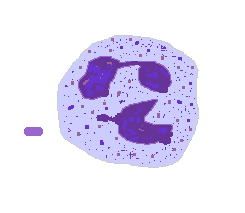
|
The process of phagocytosis of an infectious agent by a neutrophil is shown above. The microbe can become coated with opsonins such as the C3b complement component, or immunoglobulins. The phagocyte, in this case a neutrophil, has C3b and Fc receptors to bind the microbe, triggering engulfment. The ingested microbe is contained within a phagosome that fuses with a lysosome in the cytoplasm, yielding a phagolysosome in which the microbe is destroyed by the lysosomal enzymes. Phagocytosis induces a burst in oxidative metabolism, with activation of NADPH oxidase, which generates superoxide and creates free radicals (reactive oxygen intermediates). Superoxide is converted to hydrogen peroxide. In the presence of myeloperoxidase, an enzyme contained within neutrophil granules, along with chloride ion, hydrogen peroxidase is converted to HOCl. This is the most powerful bactericidal system in neutrophils. Inherited disorders of superoxide generation result in the disease known as chronic granulomatous disease. Additional antibacterial products of neutrophil granules include lysozyme and lactoferrin. |